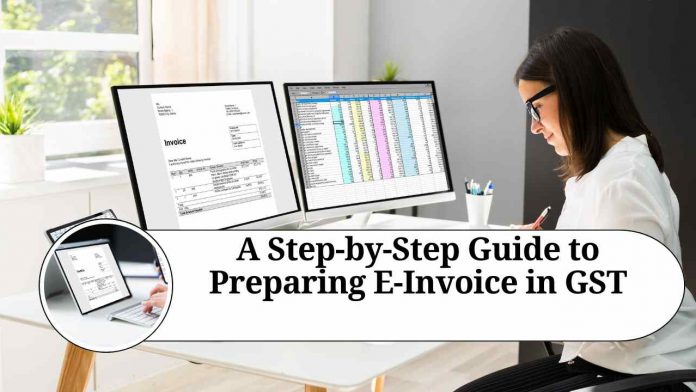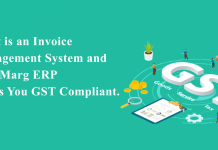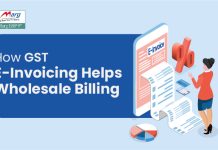Recent Updates on e-Invoicing:
10th May 2023
The implementation of the 6th phase of e-invoicing has been announced by the CBIC, aligning with the government’s goal of establishing a digital economy. Beginning on August 1st, 2023, companies that have had an annual turnover of ?5 crore or more since the 2017-18 financial year will be required to generate e-invoices.
Introduction
The introduction of Goods and Services Tax (GST) in many countries has revolutionized the way businesses handle their invoicing processes. One of the key advancements in GST is the introduction of e-invoicing, a digital mechanism that streamlines invoice generation, transmission, and verification. In this blog post, we will walk you through the process of preparing an e-invoice in GST, providing you with a step-by-step guide to ensure compliance and efficiency in your invoicing operations.
Understand the Basics of E-Invoicing:
Before diving into the process, it’s essential to familiarize yourself with the basics of e-invoicing in the context of GST. E-invoicing is a system in which invoices are electronically generated, validated, and reported directly to the GST portal. It enables seamless data exchange between businesses and tax authorities, promoting transparency and reducing the chances of errors and fraud.
Obtain the Necessary Tools:
To prepare e-invoices in GST, you will need appropriate software or an accounting solution that supports e-invoicing. Make sure you choose a reliable software provider that complies with the GST guidelines and has the necessary features to generate and transmit e-invoices.
Validate Your GSTIN:
Ensure that your Goods and Services Tax Identification Number (GSTIN) is active and valid. This is crucial, as incorrect or expired GSTINs can lead to complications during the e-invoicing process.
Generate the E-Invoice:
Once you have the necessary software and validated GSTIN, you can begin generating e-invoices. The software should provide a user-friendly interface where you can input all the relevant details, including invoice number, date, customer details, item descriptions, quantity, unit price, and applicable taxes. It should also calculate the total invoice value automatically.
Include Unique Invoice Reference Number (IRN):
The software will generate a unique Invoice Reference Number (IRN) for each e-invoice. This number acts as a unique identifier for the invoice and is crucial for GST compliance. The IRN is obtained by digitally signing the invoice data and submitting it to the Invoice Registration Portal (IRP).
- Authenticate the E-Invoice:
Once the invoice data is submitted to the IRP, it will authenticate the information and generate a QR code containing essential invoice details. This QR code is an important element of the e-invoice and must be included in the final document.
Report to the GST Portal:
After obtaining the authenticated e-invoice from the IRP, it should be reported to the GST portal for further processing and compliance. Your e-invoicing software should have the capability to seamlessly transmit the e-invoice data to the GST portal, ensuring accuracy and adherence to GST regulations.
Maintain Records:
As per GST guidelines, businesses are required to maintain copies of e-invoices for a specified period. Make sure you have a robust record-keeping system in place to store e-invoices digitally or in physical form, as per your preference.
Conclusion
E-invoicing in GST is a significant step towards simplifying and digitizing the invoicing process, reducing errors, and ensuring compliance. By following the step-by-step guide outlined in this blog, businesses can prepare e-invoices efficiently and meet the requirements set by the GST authorities. Embracing e-invoicing not only enhances operational efficiency but also contributes to the overall growth and development of businesses in the GST ecosystem. So, get started with e-invoicing today and experience the benefits it offers.
Read more useful content:
Frequently Asked Questions (FAQs)
Q1: What is an e-invoice in GST?
A1: An e-invoice in GST refers to an electronically generated invoice that complies with the standardized format set by the Goods and Services Tax authorities. It contains the necessary details of a transaction and is digitally signed for authenticity.
Q2: Is e-invoicing mandatory in GST?
A2: Yes, e-invoicing is mandatory for businesses with an aggregate turnover exceeding a specified threshold. The threshold may vary depending on the country’s GST regulations.
Q3: What software or tools do I need to prepare e-invoices in GST?
A3: To prepare e-invoices in GST, you will need accounting or invoicing software that supports e-invoicing. Ensure that the software is compliant with GST guidelines and has the necessary features to generate, validate, and transmit e-invoices.
Q4: How do I generate an e-invoice in GST?
A4: To generate an e-invoice in GST, you need to enter all the relevant details, such as invoice number, date, customer information, item descriptions, quantities, unit prices, and applicable taxes, into the e-invoicing software. The software should calculate the total invoice value automatically.
Q5: What is an Invoice Reference Number (IRN)?
A5: The Invoice Reference Number (IRN) is a unique identifier generated for each e-invoice. It is obtained by digitally signing the invoice data and submitting it to the Invoice Registration Portal (IRP). The IRN is essential for GST compliance and must be included in the e-invoice.
Q6: How do I authenticate an e-invoice?
A6: After submitting the invoice data to the IRP, it authenticates the information and generates a QR code containing essential invoice details. This QR code, along with the digitally signed e-invoice, confirms the authenticity of the document.
Q7: How do I report the e-invoice to the GST portal?
A7: Once the e-invoice is authenticated, it should be reported to the GST portal for further processing and compliance. Your e-invoicing software should have the capability to seamlessly transmit the e-invoice data to the GST portal.
Q8: What records do I need to maintain for e-invoices in GST?
A8: As per GST guidelines, businesses are required to maintain copies of e-invoices for a specified period, usually six to eight years. Ensure you have a robust record-keeping system in place to store e-invoices digitally or in physical form.
Q9: Can I make corrections to an e-invoice after it has been generated?
A9: No, once an e-invoice has been generated and authenticated, it cannot be edited or modified. In case of errors, you will need to issue a credit note or a revised invoice to rectify the mistake.
Q10: How does e-invoicing benefit businesses in GST?
A10: E-invoicing offers several benefits to businesses, including reduced errors in invoicing, streamlined compliance with GST regulations, faster invoice processing, enhanced transparency, and improved efficiency in financial operations.




















